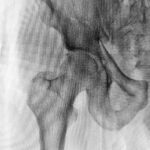 Juvenile Paget disease (JPD) is an ultra-rare disease, characterized by loss of function of osteoprotegerin. Osteoprotegerin inhibits osteoclast activation via the receptor activator of nuclear factor κB (RANK) pathway. Severely affected children suffer from bone deformities and pain and require long term anti-resorptive treatment. Due to the rarity of the disease, few long-term follow-up data on the clinical course in children are available. In this report, motor development during infancy and early childhood and the activity of the bone disease based on clinical, radiographic and biochemical parameters are reported in 2 children with severe forms of JPD during long term treatment (4 and 14 years) with bisphosphonates. Results of a bone biopsy in patient 1 after 10 years of treatment and video material of the motor development of patient 2 are provided. Doses per year of pamidronate ranged from 4 to 9 mg/kg bodyweight and were administered in 4-10 courses, yearly. Treatment was adjusted individually according to the presence of bone pain. Motor development was delayed in both children before treatment with bisphosphonates was commenced and improved thereafter. Bone histology revealed a significantly higher heterogeneity of mineralization which was mainly attributed to the increased percentage of low mineralized bone areas. Individualized intravenous treatment with pamidronate resulted in sufficient control of bone pain and suppression of bone turnover with few side effects over the observation period.
Juvenile Paget disease (JPD) is an ultra-rare disease, characterized by loss of function of osteoprotegerin. Osteoprotegerin inhibits osteoclast activation via the receptor activator of nuclear factor κB (RANK) pathway. Severely affected children suffer from bone deformities and pain and require long term anti-resorptive treatment. Due to the rarity of the disease, few long-term follow-up data on the clinical course in children are available. In this report, motor development during infancy and early childhood and the activity of the bone disease based on clinical, radiographic and biochemical parameters are reported in 2 children with severe forms of JPD during long term treatment (4 and 14 years) with bisphosphonates. Results of a bone biopsy in patient 1 after 10 years of treatment and video material of the motor development of patient 2 are provided. Doses per year of pamidronate ranged from 4 to 9 mg/kg bodyweight and were administered in 4-10 courses, yearly. Treatment was adjusted individually according to the presence of bone pain. Motor development was delayed in both children before treatment with bisphosphonates was commenced and improved thereafter. Bone histology revealed a significantly higher heterogeneity of mineralization which was mainly attributed to the increased percentage of low mineralized bone areas. Individualized intravenous treatment with pamidronate resulted in sufficient control of bone pain and suppression of bone turnover with few side effects over the observation period.
Read the full article here.
